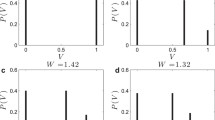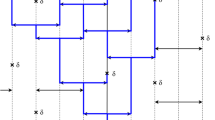Abstract
We prove the existence of a phase transition for a stochastic model of interacting neurons. The spiking activity of each neuron is represented by a point process having rate 1 whenever its membrane potential is larger than a threshold value. This membrane potential evolves in time and integrates the spikes of all presynaptic neurons since the last spiking time of the neuron. When a neuron spikes, its membrane potential is reset to 0 and simultaneously, a constant value is added to the membrane potentials of its postsynaptic neurons. Moreover, each neuron is exposed to a leakage effect leading to an abrupt loss of potential occurring at random times driven by an independent Poisson point process of rate \( \gamma > 0 .\) For this process we prove the existence of a value \(\gamma _c\) such that the system has one or two extremal invariant measures according to whether \(\gamma > \gamma _c \) or not.
Similar content being viewed by others
References
Bertein, F., Galves, A.: Une classe de systèmes de particules stable par association. Z. Wahr. Verw. Gebiete 41, 73–85 (1977)
Braitenberg, V., Schüz, A.: Cortex: Statistics and Geometry of Neuronal Connectivity, 2nd edn. Springer, Berlin (1998)
Brémaud, P., Massoulié, L.: Imbedded construction of stationary sequences and point processes with a random memory. Queueing Syst. 17(1–2), 213–234 (1994)
Brochini, L., Costa, A.A., Abadi, M., Roque, A.C., Stolfi, J., Kinouchi, O.: Phase transitions and self-organized criticality in networks of stochastic spiking neurons. Sci. Rep. 6, 35831 (2016)
Cowan, J.: Stochastic Wilson-Cowan equations for networks of excitatory and inhibitory neurons. (2011) http://www-sop.inria.fr/manifestations/SemesterCirm/slides/cowan
De Masi, A., Galves, A., Löcherbach, E., Presutti, E.: Hydrodynamic limit for interacting neurons. J. Stat. Phys. 158(4), 866–902 (2015)
Duarte, A., Ost, G., Rodríguez, A.A.: Hydrodynamic limit for spatially structured interacting neurons. J. Stat. Phys. 161(5), 1163–1202 (2015)
Fournier, N., Löcherbach, E.: On a toy model of interacting neurons. In: Ann. Inst. H. Poincar Probab. Statist, vol. 52, pp. 1844–1876 (2016)
Galves, A., Löcherbach, E.: Infinite systems of interacting chains with memory of variable length—a stochastic model for biological neural nets. J. Stat. Phys. 151(5), 896–921 (2013)
Galves, A., Löcherbach, E.: Modeling networks of spiking neurons as interacting processes with memory of variable length. J. Société Française Stat. 157, 17–32 (2016)
Griffeath, D.: The basic contact process. Stoch. Proc. Appl. 11, 151–185 (1981)
Harris, T.E.: On a class of set-valued markov processes. Ann. Probab. 4(2), 175–194 (1976)
Harris, T.E.: Additive set-valued markov processes and graphical methods. Ann. Probab. 6(3), 355–378 (1978)
Kilpatrick, ZP.: Wilson-Cowan model. In: Encyclopedia of Computational Neuroscience, pp. 3159–3163. Springer, New York (2015)
Liggett, T.M.: Interacting Particle Systems. Springer, Berlin (1985)
Rissanen, J.: A universal data compression system. IEEE Trans. Inf. Theory 29(5), 656–664 (1983)
Robert, P., Touboul, J.: On the dynamics of random neuronal networks. J. Stat. Phys. 165(3), 545–584 (2016)
Sporns, O.: The non-random brain: efficiency, economy, and complex dynamics. Front. Comput. Neurosci. 5, 5 (2011)
Wilson, H.R., Cowan, J.D.: Excitatory and inhibitory interactions in localized populations of model neurons. Biophys. J. 12(1), 1–24 (1972)
Wilson, H.R., Cowan, J.D.: A mathematical theory of the functional dynamics of cortical and thalamic nervous tissue. Kybernetik 13(2), 55–80 (1973)
Yaginuma, K.: A stochastic system with infinite interacting components to model the time evolution of the membrane potentials of a population of neurons. J. Stat. Phys. 163(3), 642–658 (2016)
Acknowledgements
Many thanks to Marzio Cassandro and Christophe Pouzat for illuminating discussions, constructive criticism and useful information on neurobiology. This research has been conducted as part of the project Labex MME-DII (ANR11-LBX-0023-01) and it is part of USP project Mathematics, computation, language and the brain and of FAPESP project Research, Innovation and Dissemination Center for Neuromathematics (Grant 2013/07699-0). AG is partially supported by CNPq fellowship (Grant 311 719/2016-3).
Author information
Authors and Affiliations
Corresponding author
Rights and permissions
About this article
Cite this article
Ferrari, P.A., Galves, A., Grigorescu, I. et al. Phase Transition for Infinite Systems of Spiking Neurons. J Stat Phys 172, 1564–1575 (2018). https://doi.org/10.1007/s10955-018-2118-6
Received:
Accepted:
Published:
Issue Date:
DOI: https://doi.org/10.1007/s10955-018-2118-6
Keywords
- Systems of spiking neurons
- Interacting point processes with memory of variable length
- Additivity and duality
- Phase transition




